Green-eyed tree frog genome
The gree-eyed tree frog, Litoria serrata, is a species of the super genus Litoria (Family Pelodryadidae, Australopapuan Treefrogs) which comprises ~35% of Australia’s ~250 frog species.

The Litoria group has been invaluable in elucidating mechanisms of speciation, for example, reinforcement in L. serrata/L. myola (Hoskin et al. 2005) and hybrid zones in L. ewingii/L. paraewingi (Littlejohn). Some Litoria species have also seen major declines due to chytridiomycosis, for example L. lorica (Puschendorf et al. 2011) and L. raniformis (Heard et al. 2015). Promisingly, other species have recovered since and constitute good candidate models for adaptations to the disease, for example, L. nannotis and L. serrata (McKnight et al. 2019). The Litoria species also occupy a wide range of habitats, from acid wallum swamps (e.g., L. olongburensis) to deserts (e.g., L. rubella) to many rainforest and wet forest species, and a wide range of breeding strategies from pond breeders to waterfall specialists. The frog species within the genus Cyclorana, which sits within Litoria (thereby making Litoria paraphyletic) are all explosive breeders. They do so by emerging from aestivation, an adaptation to the extreme aridity of Australia whereby frogs burrow into the ground and enter dormancy for many months until the next rains arrive. Therefore, a reference genome for the supergenus Litoria would be invaluable for many different areas of Australian amphibian research.
Project coordinator:
- Megan Higgie (JCU)
Project collaborators:
- Lorenzo Bertola (JCU)
- Conrad Hoskin (JCU)
- Arthur Georges (University of Canberra)
- Renee Catullo (University of Western Australia)
References cited:
- Richard, S. et al. 2010. Taxonomic re-assessment of the Australian and New Guinean green-eyed treefrogs Litoria eucnemis, L. genimaculata and L. serrata (Anura: Hylidae). Zootaxa 2391
Resources:
- Atlas of Living Australia: Litoria serrata
